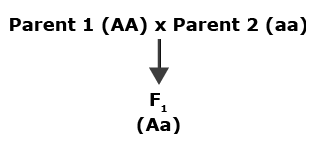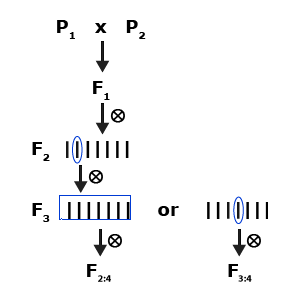Chapter 2: Pedigree Naming Systems and Symbols
Asheesh Singh; Anthony A. Mahama; and Walter Suza
Understanding the symbols used to describe the progeny generated following hybridization and self-pollination is critical for clear communication between/among researchers in the breeding community. The two symbols used by plant breeders to enable such communication are F and S, where F is derived from the word filial, defined as the sequence of generations after the mating of two parents. S is the symbol used to denote generations of self-pollination. Different systems exist in the use of the F and S symbols to describe breeding groups – populations, individuals, and inbred lines – making it the more crucial to avoid misleading outcomes by clearly stating the meaning of symbols, and thus underscores that advantages and disadvantages exist in the use of each system.
- Demonstrate the relationship between the “F” and “S” symbols used to designate generations of selfing or sib-mating.
- Describe how breeding lines are designated by “F#:#” or “S#:#” according to the generation that they were derived.
- Demonstrate pedigree writing.
- Demonstrate how selection history is recorded using a Breeder’s Cross Identification (BCID) designation.
Using F# and S#
Symbology
A. Using “F#” and “S#” to designate the number of generations of selfing or sib-mating:
In plant breeding, the ‘F’ symbol is used to denote the filial (i.e., family) generation of offspring following a cross between two or more parents. The subscript (#) represents the specific generation (F#). F1 is the first generation following a cross and subsequent generations are designated F2, F3, F4, etc., based on the number of generations the offspring are self-pollinated or sib-pollinated (i.e., pollinated by a sibling plant in the same progeny row). Pollination can occur naturally or artificially if it is imposed by the breeder. If both of the parents of a cross are homozygous then the F1 offspring will be homogeneous (i.e., all plants will be uniform and genetically the same) and heterozygous at individual loci. If either or both of the parents are heterozygous then the F1 offspring will be heterogeneous (non-uniform). In a complex cross involving more than two parents, even if the parents are homozygous), the F1 generation will be heterogeneous and heterozygous.
Single Gene Example With Two Homozygous Parents

In the example above (Fig. 1) , both parents were developed by the breeder after undergoing several generations of selfing so that they are homozygous at all loci. The cross between these two unrelated parents produces F1 progeny that are all uniformly heterozygous (Aa), and F1 progeny population (all F1 from this cross) will be homogeneous since each F1 will be ‘Aa’ type at this locus.
Self-Pollination
When an F1 plant is self-pollinated or when two F1 plants are crossed with each other, F2 seed is produced. If the parents were homozygous then the F2 generation is the first generation when the offspring are heterogeneous (i.e., segregating for different parental alleles). The F2 generation is typically the generation when selection for simple traits begins. Self-pollination of F2 plants produces F3 plants, self-pollination of F3 plants produces F4 plants, and so on as shown in Fig. 2.

Cross-Pollinated Species
In cross-pollinated species, ‘S#’ is used instead of ‘F#’. The symbol S0 can be used to describe the progeny from a single cross between two homozygous parents as either:
- Similar to F1 (in self-pollinated) which indicates that the plant was not derived from self-pollination or
- Similar to F2 (in self-pollinated) which indicates that the population is formed by random mating and is therefore heterogeneous and heterozygous
Therefore, it is important that the breeder clearly describes what she/he is referring to in a particular situation and then be consistent in usage.
Using Fx:y and Sx:y
Breeding Lines
B. Using “Fx:y” or “Sx:y” to describe breeding lines according to the generation they were derived:
Breeding lines (or genotypes) are derived from individual plants at various generations. An F2:4 line refers to an F4 line that was derived from a single F2 plant. The F2 plant was selfed to produce F3 seeds, which were then grown in a single F3 progeny row, self-pollinated, and then harvested as a F4 bulk of many or all of the F3 plants in this row. Based on this scheme each individual F2 plant gives rise to a genetically distinct F2:4 line. These lines are also described as “F2-derived lines in the F4 generation”, or simply “F2-derived F4 lines”.
Summary
An F3:4 line refers to an F4 line (or progeny row) created from a single F3 plant growing in an F3 progeny row that was produced from the seed of a self pollinated single F2 plant. An individual plant was selected from an F3 row to produce F4 seed and this seed when grown represents an F3:4 line. These are also described as “F3-derived lines in the F4 generation”, or simply “F3-derived F4 lines”. The difference from F2:4 lines is because the first subscript designates the generation of the last individual-plant selection (Fig. 3).
To summarize:
Fx:y or Sx:y , describes ‘x’ as the generation where single plant was harvested separately to give rise to the derived line, and y represents the current generation of inbreeding of the plants within this derived line.

Writing a Standard Pedigree
Symbology
C. Example of writing a standard pedigree:
Each organization follows a different standardized system for recording pedigrees. In this section, we will describe the system adapted from Purdy et al (1968) modified and used by wheat breeders at CIMMYT (CGIAR institute). Depending on the crop you work on and where you are employed you may use a modified system.
The female parent is designated by listing it first (starting from the left) followed by the male parent (on the right). For example, A is the female parent and B is the male parent in an (A x B) cross. An (A x B) cross can also be written as A/B.
If an F1 (A/B) plant is pollinated with parent C, and the F1 is used as the female and C as the male, the resulting three-way cross would be designated as A/B//C. Subsequent crosses with parental materials D, E, F, and G used sequentially (all as males) are indicated using a number to record the cross order in the following way: A/B//C/3/D/4/E/5/F/6/G.
Example
If the example above is changed to use D & F as female parents, with E and G remaining as males, the cross would be recorded as follows:
- Step 1: A/B is the first cross,
- Step 2: A/B//C is the second cross, where A/B is the female.
- Step 3: D/3/A/B//C is the third cross, with D as female, and A/B//C as male.
- Step 4: D/3/A/B//C/4/E, with E as male, and the 4-parent cross as the female. NOTE: bold and underline text is for information and instructional purpose only. In writing a pedigree, you will not have to bold text. One will simply write the pedigree as D/3/A/B//C/4/E
The inclusion of “5/F” as the female and 6/G as a male completes the pattern.
Backcross Pedigree
In multiple backcrosses, the sequence of these letters from left to right corresponds to the sequence in which the backcrosses are made. Backcross pedigrees include an asterisk (*) and a number indicating the dosage of the recurrent parent. The asterisk and the number are placed next to the crossing symbol (/) that divides the recurrent and donor parents. The following are examples of pedigree formats involving backcrosses:
- A is the recurrent parent: A*2/B of the initial cross and has been used as a parent two times. Therefore, A*2/B indicates one backcross or a BC1 cross.
- B is the recurrent parent: A/3*B, and has been used as a parent three times. Therefore, A/3*B indicates a BC2 cross.
A*2/B is therefore A//A/B and indicates that A was used as a female in both F1 and BC1.
A/3*B could be B/3/A/B//B and indicates that A was used as a female, F1 was then used as female, and BC1 was used as male.
A/3*B could be A/B//B/3/B and indicates that A was used as a female, F1 was then used as female, and BC1 was used as a female.
The F#: derived symbols as previously described for regular crosses will follow the BC# designation. For example, BC1F2:4 or BC2F2:4.
Identity Number
Assigning an Identity Number to Each Cross or Backcross
Every cross should receive a unique ID number that will allow everyone in the breeding group to recognize the year the cross was made (e.g., 2014), a cross number (e.g., 1001), and perhaps the target purpose of the cross (e.g., HO for high-oil, or abbreviation for another specific trait or market segment).
Using BCID
Recording Selection History
D. Recording selection history using a Breeder’s Cross IDentification (BCID) designation:
Every F1 plant, segregating line, or advanced line in a program is assigned a Breeders’ Cross IDentification (BCID) and a selection history. This selection history records the process of selection, which describes where and how the initial cross was made and where and how subsequent selection steps occurred for each generation of selection.
Example
An example of this system is provided below (using CIMMYT’s wheat breeding program).
Each BCID begins with a letter designation for the origin of the cross (e.g., CM = crusa Mexicana; Spanish for ‘Mexican cross’). This is followed by an indication of the kind of cross (e.g., BW = bread wheat x winter wheat, SS = spring x spring wheat; SW = spring x winter wheat), an abbreviation of the year when the cross was made (e.g., 00 = 2000), an abbreviation of the location where the cross was made (e.g., Y = Yaqui Valley), and finally a sequential number representing the order in which that cross was made within the crossing cycle (e.g., 0124). The table below shows the letter codes used to indicate the locations in Mexico where crosses were made and the different environmental conditions where CIMMYT breeders carry out selection in wheat. Note that more than abbreviations than shown in table are used to describe locations or nurseries.
| Code | Description of Location and/or Environmental Condition |
|---|---|
| B | El Batan |
| M | Toluca (“M” stands for the State of Mexico) |
| Y | Cd. Obregon full irrigation (Cd. = Cuidad = city; “Y” stands for Yaqui valley region in Mexico) |
| KBY | Cd. Obregon Karnal bunt |
| HY | Cd. Obregon Heat (heat, late planting) |
| SY | Cd. Obregon Semi-arid (reduced irrigation) |
| PR | Poza Rica |
| PZ | Patzcuaro |
| SJ | Sierra de Jalisco (El Tigre) |
| AL | Selection for tolerance to low pH and aluminum toxicity in laboratory test (El Batan) |
| YDB | Selection for BYDV tolerance in El Batan (BYDV = barley yellow dwarf virus) |
Location Codes
Location codes for other countries were determined by the cooperators/breeders in those countries to ensure that everyone was aware and compliant. Hypothetical examples of BCIDs and selection histories are presented below.
| Example # | Type of cross | Breeder’s Cross ID (BCID) |
Selection history (by generation) | ||||||
| n/a | n/a | n/a | F1 | F2 | F3 | F4 | F5 | F6 | F7 |
| 1 | A/B | CMBW08Y0199 | n/a | 35Y | 15M | 7Y | 5M | 12Y | 0M |
| 2 | A/B | CMBW08Y0124 | n/a | 81Y | 010M | 010Y | 010M | 15Y | 0M |
| 3 | A/B | CMSS07Y051 | n/a | 030Y | 030M | 030Y | 53Y | 0M | n/a |
- Example 1: BCID = CMBW08Y0199, a single cross was made in Mexico (“CM”) in 2008 between a bread and winter wheat at location ‘Y’ and this was cross# 0199 that year. The pedigree method of selection was followed for the development of the genotype. The selection history for this example indicates that in the F2, the 35th plant was selected at location “Y”, and in the F3 generation this was the 15th plant selected at location “M”, etc. Finally, in the F7 the “0M” indicates that a single plot was grown at location “M” and harvested in bulk (i.e., all plants in the plot were harvested into one bag or packet). This created the genotype CMBW08Y0199-35Y-15M-7Y-5M-12Y-0M.
- Example 2: BCID = CMBW08Y0124, a single cross was made in Mexico (“CM”) in 2008 at location “Y”, with 0124 designating that this cross was number 0124 in the series of crosses made at that location and year. The selection history reflects that a modified pedigree/bulk selection method was used. In the F2 the “81Y” indicates that this genotype was the 81st individual plant among those selected at location “Y.” The F3 designation of “010M” indicates that 10 plants were selected and harvested in bulk from the F3 progeny row grown at location “M.” Seed from the bulked F3 progeny row was planted at location “Y” in the F4 and 10 plants were selected and harvested in bulk. Similar scheme was used in F5. In the F6 a single plant was selected from this genotype (15th plant) at location “Y” and constituted the seed for the next generation. In the F7 (or more appropriately, F6:7) all plants in the progeny row at location “M” were harvested in bulk, as shown by the designation “0M”. This created the genotype CMBW08Y0124-81Y-010M-010Y-010M-15Y-0M.
- Example 3: BCID = CMSS07Y051, which describes that a single cross was made in Mexico (“CM”) in 2007 at location “Y”, with 051 designating that this cross was number 051 in the series of crosses made at that location and year. The cross was of type “SS”, spring wheat x spring wheat. The selection history indicates four generations (F2-F4) of selection in which 30 plants were bulked from the progeny row (or plot) for each season at either the “M” or “Y” locations. In the F5 generation the genotype selected was the 53rd plant from the bulk plot at the “Y” location. In the F6 a complete plot bulk was harvested at location “M”. This lead to the creation of the genotype CMSS07Y051-030Y-030M-030Y-53Y-0M.
Additional Notes
After the BCID, the selection history is presented in which the numbers identify the number of individual plant(s) selected and the letter indicates the location where selection took place and/or under what specific conditions selection was conducted.
The zero-letter combinations (e.g., 0Y, 0M, etc.) are reserved for populations harvested in bulk during that generation (i.e., the entire plot was cut and threshed as one unit). A zero followed by a number (e.g., 05…, 010…) and then by a letter indicates that the modified pedigree/bulk selection method was used in which a certain number (e.g., 5 or 10) of selected heads are bulk (0) harvested. The location where the selection was made and, in some cases, the special type of selection performed, is indicated by a letter code.
References
Purdy, L.H., W.Q. Loegering, C.F. Konzak, C.J. Peterson, and R.E. Allan. 1968. A Proposed Standard Method for Illustrating Pedigrees of Small Grain Varieties. Crop Science 8:405-406.

